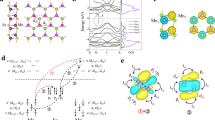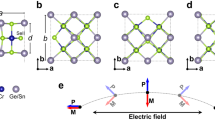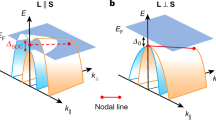Abstract
Electric control of magnetism and magnetic control of ferroelectricity can improve the energy efficiency of magnetic memory and data-processing devices1. However, the necessary magnetoelectric switching is hard to achieve, and requires more than just a coupling between the spin and the charge degrees of freedom2,3,4,5. Here we show that an application and subsequent removal of a magnetic field reverses the electric polarization of the multiferroic GdMn2O5, thus requiring two cycles to bring the system back to the original configuration. During this unusual hysteresis loop, four states with different magnetic configurations are visited by the system, with one half of all spins undergoing unidirectional full-circle rotation in increments of about 90 degrees. Therefore, GdMn2O5 acts as a magnetic crankshaft that converts the back-and-forth variations of the magnetic field into a circular spin motion. This peculiar four-state magnetoelectric switching emerges as a topologically protected boundary between different two-state switching regimes. Our findings establish a paradigm of topologically protected switching phenomena in ferroic materials.
This is a preview of subscription content, access via your institution
Access options
Access Nature and 54 other Nature Portfolio journals
Get Nature+, our best-value online-access subscription
$29.99 / 30 days
cancel any time
Subscribe to this journal
Receive 51 print issues and online access
$199.00 per year
only $3.90 per issue
Buy this article
- Purchase on Springer Link
- Instant access to full article PDF
Prices may be subject to local taxes which are calculated during checkout




Similar content being viewed by others
Data availability
The data that support the findings of this study are available at https://doi.org/10.5281/zenodo.5817751.
Code availability
The code of the model used to produce the fits is available on GitHub at https://github.com/louisponet/GdMn2O5_paper.
References
Bibes, M. & Barthélémy, A. Towards a magnetoelectric memory. Nat. Mater. 7, 425–426 (2008).
Kleemann, W. Magnetoelectric spintronics. J. Appl. Phys. 114, 027013 (2013).
Heron, J. T. et al. Deterministic switching of ferromagnetism at room temperature using an electric field. Nature 516, 370–373 (2014).
Matsukura, F., Tokura, Y. & Ohno, H. Control of magnetism by electric fields. Nat. Nanotechnol. 10, 209–220 (2015).
Manipatruni, S., Nikonov, D. E. & Young, I. A. Beyond CMOS computing with spin and polarization. Nat. Phys. 14, 338–343 (2018).
Bhatti, S. et al. Spintronics based random access memory: a review. Mater. Today 20, 530–548 (2017).
Khan, A. I., Keshavarzi, A. & Datta, S. The future of ferroelectric field-effect transistor technology. Nat. Electron. 3, 588–597 (2020).
Zhang, Z. et al. Memory materials and devices: from concept to application. InfoMat 2, 261–290 (2020).
Spaldin, N. A. & Ramesh, R. Advances in magnetoelectric multiferroics. Nat. Mater. 18, 203–212 (2019).
Khomskii, D. Classifying multiferroics: mechanisms and effects. Physics 2, 20 (2009).
Fiebig, M. Revival of the magnetoelectric effect. J. Phys. D 38, R123 (2005).
Fiebig, M., Lottermoser, T., Meier, D. & Trassin, M. The evolution of multiferroics. Nat. Rev. Mater. 1, 16046 (2016).
Cheong, S.-W. & Mostovoy, M. Multiferroics: a magnetic twist for ferroelectricity. Nat. Mater. 6, 13–20 (2007).
Scott, J. F. Room-temperature multiferroic magnetoelectrics. NPG Asia Mater. 5, e72 (2013).
Tokunaga, Y. et al. Composite domain walls in a multiferroic perovskite ferrite. Nat. Mater. 8, 558–562 (2009).
Tokunaga, Y., Taguchi, Y., Arima, T.-H. & Tokura, Y. Electric-field-induced generation and reversal of ferromagnetic moment in ferrites. Nat. Phys. 8, 838–844 (2012).
Vanderbilt, D. Berry Phases in Electronic Structure Theory: Electric Polarization, Orbital Magnetization and Topological Insulators (Cambridge Univ Press, 2018).
Alonso, J., Casais, M., Martínez-Lope, M. & Fernández-Díaz, M. A structural study from neutron diffraction data and magnetic properties of RMn2O5 (R = La, rare earth). J. Phys. Condens. Matter 9, 8515–8526 (1997).
Chapon, L. et al. Structural anomalies and multiferroic behavior in magnetically frustrated TbMn2O5. Phys. Rev. Lett. 93, 177402 (2004).
Chapon, L., Radaelli, P., Blake, G., Park, S. & Cheong, S. Ferroelectricity induced by acentric spin-density waves in YMn2O5. Phys. Rev. Lett. 96, 097601 (2006).
Kim, J.-H. et al. Magnetic excitations in the low-temperature ferroelectric phase of multiferroic YMn2O5 using inelastic neutron scattering. Phys. Rev. Lett. 107, 097401 (2011).
Lee, N. et al. Giant tunability of ferroelectric polarization in GdMn2O5. Phys. Rev. Lett. 110, 137203 (2013).
Giovannetti, G. & van den Brink, J. Electronic correlations decimate the ferroelectric polarization of multiferroic HoMn2O5. Phys. Rev. Lett. 100, 227603 (2008).
Bukhari, S. H. et al. Magnetoelectric phase diagrams of multiferroic GdMn2O5. Phys. Rev. B 94, 174446 (2016).
Munõz, A. et al. Magnetic structure and properties of BiMn2O5: a neutron diffraction study. Phys. Rev. B 65, 144423 (2002).
Vecchini, C. et al. Commensurate magnetic structures of RMn2O5 (R = Y, Ho, Bi) determined by single-crystal neutron diffraction. Phys. Rev. B 77, 134434 (2008).
Oh, Y. S. et al. Non-hysteretic colossal magnetoelectricity in a collinear antiferromagnet. Nat. Commun. 5, 3201 (2014).
Rice, M. J. & Mele, E. J. Elementary excitations of a linearly conjugated diatomic polymer. Phys. Rev. Lett. 49, 1455–1459 (1982).
Lohse, M., Schweizer, C., Zilberberg, O., Aidelsburger, M. & Bloch, I. A Thouless quantum pump with ultracold bosonic atoms in an optical superlattice. Nat. Phys. 12, 350–354 (2016).
Nakajima, S. et al. Topological thouless pumping of ultracold fermions. Nat. Phys. 12, 296–300 (2016).
Atala, M. et al. Direct measurement of the Zak phase in topological Bloch bands. Nat. Phys. 9, 795–800 (2013).
Sushkov, A., Mostovoy, M., Valdés Aguilar, R., Cheong, S.-W. & Drew, H. Electromagnons in multiferroic RMn2O5 compounds and their microscopic origin. J. Phys. Condens. Matter 20, 434210 (2008).
Ren, W. E. W. & Vanden-Eijnden, E. String method for the study of rare events. Phys. Rev. B 66, 052301 (2002).
Mills, G., Jónsson, H. & Schenter, G. K. Reversible work transition state theory: application to dissociative adsorption of hydrogen. Surf. Sci. 324, 305–337 (1995).
Acknowledgements
This work was supported by the Austrian Science Funds (I 2816-N27 and P 32404-N27). The work at Rutgers University was supported by the DOE under grant number DOE: DE-FG02-07ER46382. M.M. acknowledges Vrije FOM-programma ‘Skyrmionics’.
Author information
Authors and Affiliations
Contributions
Andrei Pimenov initiated the project; Andrei Pimenov, S.A., M.M. and S.-W.C, supervised the project; A.S. and T.K. designed the experiment; X.W. grew the samples; Anna Pimenov, T.K. and J.W. characterized the samples using various techniques; J.W. and T.K. conducted the experiments and analysed the data; L.P., S.A. and M.M. developed the theory; L.P., S.A., Andrei Pimenov and M.M. wrote the manuscript with the feedback from all authors.
Corresponding author
Ethics declarations
Competing interests
The authors declare no competing interests.
Peer review
Peer review information
Nature thanks Hena Das and the other, anonymous, reviewer(s) for their contribution to the peer review of this work.
Additional information
Publisher’s note Springer Nature remains neutral with regard to jurisdictional claims in published maps and institutional affiliations.
Extended data figures and tables
Extended Data Fig. 1 Magic-angle region.
The panels demonstrate the influence of selected model parameters on the magic-angle region. In each panel only the parameter labelled on the vertical axis is varied, whereas the others are kept at the values reported in the text of this section, and used for Fig. 3 of the main text. All parameters are reported in units of meV. The blue regions signify the low-angle switching regime, while the red denotes the high angle switching regime. The white boundary region is where the double loop switching regime occurs, characterized by a winding number of 1, and is topologically protected by the neighbouring regimes.
Extended Data Fig. 2 Switching with modified model parameters.
a–c Evolution of electric polarization \({P}_{b}\) during the magnetic field sweep cycle for various magnetic field orientations. In each panel, the changes of the curve colour from red to blue indicate the progression of the sweep cycle. The four-state switching is seen for the field at the magic orientation. The insets indicate the corresponding switching paths and winding numbers. d– Trajectories (in white) of AFM order parameter orientations \(({\varphi }_{{{\rm{L}}}_{1}},{\varphi }_{{{\rm{L}}}_{2}})\) through the field sweep cycles in different regimes. The colour map shows the energy landscape at an intermediate field \({H}^{* }\).
Extended Data Fig. 3 Simplified single chain model.
The crankshaft behaviour can be reproduced within the model that only involves the single AFM chain (purple ions), coupled to Gd ions \({{\bf{S}}}_{3}\) and \({{\bf{S}}}_{6}\) (indicated by the dashed rectangle).
Extended Data Fig. 4 Mechanism of the spin reorientation transition.
a Exchange interactions between Gd ions and neighbouring AFM Mn chains (v1,2). Easy axes for L1,2 coincide with the longer zigzag segments; for Gd – with blue lines indicating v1 exchange. b Field dependence of energy contributions: magnetodipolar interactions, Gd–Mn exchange, Zeeman energy of Gd spins and energy of antiferromagnetically ordered Mn spins, for the field pointing at 10° to the a axis. c Spin configuration in state 2 and in the states, corresponding to the saddle points at the barriers toward the neighbouring minima at \(H={H}^{* }\) (states and colour coding for spins is indicated in the inset). The numbers in blue show the field projections of magnetization difference of Gd and Mn ions in the saddle-point states. The difference of magnetization components along the field in two saddle-point states results in the asymmetric barrier evolution when the field is varied.
Extended Data Fig. 5 The spin configurations corresponding to the four states.
Gd ions are shown in green while Mn ions are in purple. The blue lines indicate the AFM zigzag chains.
Rights and permissions
About this article
Cite this article
Ponet, L., Artyukhin, S., Kain, T. et al. Topologically protected magnetoelectric switching in a multiferroic. Nature 607, 81–85 (2022). https://doi.org/10.1038/s41586-022-04851-6
Received:
Accepted:
Published:
Issue Date:
DOI: https://doi.org/10.1038/s41586-022-04851-6
This article is cited by
-
Thermal multiferroics in all-inorganic quasi-two-dimensional halide perovskites
Nature Materials (2024)
-
Organic radical ferroelectric crystals with martensitic phase transition
Nature Communications (2023)
-
Topology turns the crank on a magnetoelectric switch
Nature (2022)
Comments
By submitting a comment you agree to abide by our Terms and Community Guidelines. If you find something abusive or that does not comply with our terms or guidelines please flag it as inappropriate.



